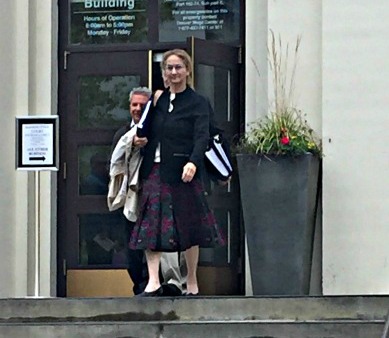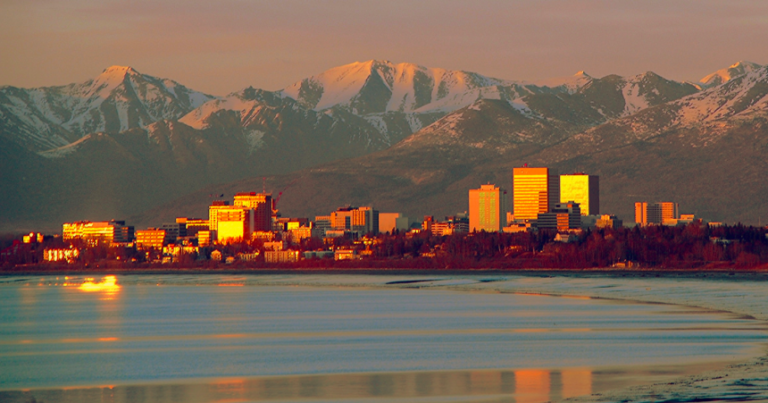The lawsuit involving the Alice Rogoff / Alaska Dispatch News eviction from the Northway building she sold to GCI faces a status hearing on Oct. 13. This particular hearing pertains to just one of the lawsuits involving the wealthy East Coast heiress who made a splash in Alaska.
Rogoff and her newspaper operation were kicked out of the building for nonpayment of rent, which precipitated her filing for Chapter 11 bankruptcy. But the evidence is growing that she intended to default as far back as January; that will be an area of inquiry as the lawsuits proceed.
The newspaper is still being printed at the Northway location, but the Binkley Company, who owns the newspaper as of this month, is looking at outsourcing the printing altogether, leaving Rogoff with the duty of removing the press from GCI’s building, a removal that is estimated to cost more than $1 million for a press that is worth its weight in scrap metal.
As everything with Alice Rogoff, who owns what and who owes what is convoluted, because Rogoff and the Alaska Dispatch News were several separate entities, a mishmash of shell corporations she had created. The fog of bankruptcy proceedings has let many assets slip through the cracks.
Rogoff was the publisher who sat in Gov. Walker’s inner circle and advised him to use the Alaska Permanent Fund as collateral, so he could borrow money to keep the state budget intact and maybe even build his gas line.
“And with today’s low interest rates, it may be the perfect time for our state to borrow. We could then take those cash loans and invest them in the markets, and earn a rate of return much higher than the interest we pay. Anything we’d earn above the interest rate could be used to help fund government,” Rogoff wrote in 2015 in her newspaper. She had brought Walker into office, and he was dancing with the one who brought him.
[Read: The state need not suffer, let’s leverage our wealth]
Rogoff may have been right in some regard to using existing wealth to create more wealth, but this is not someone from whom you’d want to take financial advice. Borrowing is her one great skill set. Paying back? Not so much.
Rogoff borrowed millions, and ran up bills with a multitude of creditors — small business owners in Alaska who will likely never get paid.
CREDITORS CHAPPED
On Friday, the court converted the remains of her legal quagmire to Chapter 7 bankruptcy — the lost cause category.
Those assets include the two presses at the Arctic Blvd. property owned by Arctic Partners. The presses, which have never been operational at the location, are orphans. The Binkley Company, which purchased the newspaper for $1 million, decided not to take them as part of the agreement.
The two presses may or may not have value beyond repurposing them into stationary anchors.
What happens next? The court will appoint a new bankruptcy trustee. The trustee will form a committee of the creditors. They’ll sort out if there’s anything left to sell.
Then, it’s going to get very personal. As in, personal assets.
Creditors, including Northrim Bank, North Coast Electric, and dozens of others, will attempt to convince the court that they are entitled to go after her personal wealth, which might include that floatplane in which Rogoff was videotaped careening along Campbell Lake earlier this month.
[Read: She’s gonna crash! Video of floatplane bouncing on Campbell Lake]
It might include taking a look at all her other private accounts, her allowance from her estranged husband, even her art collection and ivory bracelets.
Arctic Partners, which owns the building Rogoff leased on 59th and Arctic Blvd, has her personal guarantee on the lease. She also gave a personal guarantee to GCI to remove the press at the Northway location. Northrim Bank has a personal guarantee, too, on roughly $10 million in “secured debt.” The bank will be first in line after the lawyers.
A case can even be made that the napkin contract she wrote out to former partner Tony Hopfinger is a personal guarantee. That case goes to trial next March, when precious little is likely to remain to make Hopfinger whole.
The newspaper is no longer Rogoff’s concern, but her woes are far from over.
SURVIVOR’S GUILT
Alaskans who eat news for breakfast have been following the layoff drama at the Alaska Dispatch News as the Binkley Company tries to salvage the operation. Some 30 people were laid off last week. Due to a 1988 law known as the WARN act, the layoffs cannot come in one fell swoop. There will be more, however.
Readers of Must Read Alaska reportedly popped champagne bottles open last week when they learned of a couple of repeat offenders on the news staff who were shown the door.
A couple more of the worst truth-bending perpetrators are still on the payroll as of this morning, but this online publication has hope for the newspaper, which one insider has described as a “fighting a raging fire,” of out-of-control expenses. The Binkley company is working to avert the collapse brought on by Alice Rogoff’s hubris and refusal to face reality until the very last day when she could no longer pay the carriers to deliver the paper.
We’ve been reading the Facebook posts of those who departed with dignity, and those who remain at the Dispatch to carry on. The still-employed seem shell-shocked with survivor’s guilt.
It’s been a long week, and I’ve had a hard time figuring out what to say about it. I’m sad and frustrated to lose dedicated and talented colleagues, but grateful for everything I’ve learned from them, which at this point probably makes up significantly more than half of everything I know about journalism. Please extend well-wishes and job offers to all my friends who were laid off this week. Give the newspaper a chance under our new owners. And let us know if you ever feel like we’re not meeting your standards.
– ADN reporter Nat Herz on the layoffs of colleagues last week
It’s tough when people lose their jobs. But in many ways, this is the economy that Alice Rogoff helped create by deciding who would be governor and putting her thumb on the scale of elections. A lot have people have lost their jobs in this economy.
It’s an economy Alaska will survive, in time, as it does.
And it’s entirely possible the Alaska Dispatch News will also survive, in some form — under the new owners, with a different name, and likely with a much smaller ambition: the noble goal of covering the news without fear or favor.
![]()


